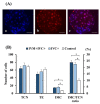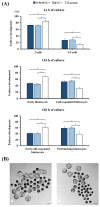Exogenous Melatonin in the Culture Medium Does Not Affect the Development of In Vivo-Derived Pig Embryos but Substantially Improves the Quality of In Vitro-Produced Embryos
- PMID: 35740074
- PMCID: PMC9220299
- DOI: 10.3390/antiox11061177
Exogenous Melatonin in the Culture Medium Does Not Affect the Development of In Vivo-Derived Pig Embryos but Substantially Improves the Quality of In Vitro-Produced Embryos
Abstract
Cloned and transgenic pigs are relevant human disease models and serve as potential donors for regenerative medicine and xenotransplantation. These technologies demand oocytes and embryos of good quality. However, the current protocols for in vitro production (IVP) of pig embryos give reduced blastocyst efficiency and embryo quality compared to in vivo controls. This is likely due to culture conditions jeopardizing embryonic homeostasis including the effect of reactive oxygen species (ROS) influence. In this study, the antioxidant melatonin (1 nM) in the maturation medium, fertilization medium, or both media was ineffective in enhancing fertilization or embryonic development parameters of in vitro fertilized oocytes. Supplementation of melatonin in the fertilization medium also had no effect on sperm function. In contrast, the addition of melatonin to the embryo culture medium accelerated the timing of embryonic development and increased the percentages of cleaved embryos and presumed zygotes that developed to the blastocyst stage. Furthermore, it increased the number of inner mass cells and the inner mass cell/total cell number ratio per blastocyst while increasing intracellular glutathione and reducing ROS and DNA damage levels in embryos. Contrarily, the addition of melatonin to the embryo culture medium had no evident effect on in vivo-derived embryos, including the developmental capacity and the quality of in vivo-derived 4-cell embryos or the percentage of genome-edited in vivo-derived zygotes achieving the blastocyst stage. In conclusion, exogenous melatonin in the embryo culture medium enhances the development and quality of in vitro-derived embryos but not in in vivo-derived embryos. Exogenous melatonin is thus recommended during embryo culture of oocytes matured and fertilized in vitro for improving porcine IVP efficiency.
Keywords: CRISPR/Cas9; apoptosis; in vitro fertilization; in vivo-derived embryos; inner cell mass; melatonin; pig; reactive oxygen species.
Conflict of interest statement
The authors declare no conflict of interest. The funders had no role in the design of the study; in the collection, analyses, or interpretation of data; in the writing of the manuscript, or in the decision to publish the results.
Figures









Similar articles
-
Comparative analysis of mouse and human preimplantation development following POU5F1 CRISPR/Cas9 targeting reveals interspecies differences.Hum Reprod. 2021 Apr 20;36(5):1242-1252. doi: 10.1093/humrep/deab027. Hum Reprod. 2021. PMID: 33609360
-
Melatonin and tannic acid supplementation in vitro improve fertilization and embryonic development in pigs.Anim Reprod. 2018 Aug 16;15(2):118-123. doi: 10.21451/1984-3143-AR2016-937. Anim Reprod. 2018. PMID: 34122642 Free PMC article.
-
Melatonin Supplementation During In Vitro Maturation and Development Supports the Development of Porcine Embryos.Reprod Domest Anim. 2015 Dec;50(6):1054-8. doi: 10.1111/rda.12607. Epub 2015 Sep 22. Reprod Domest Anim. 2015. PMID: 26392209
-
Progress in reproductive biotechnology in swine.Theriogenology. 2001 Nov 1;56(8):1291-304. doi: 10.1016/s0093-691x(01)00630-6. Theriogenology. 2001. PMID: 11758883 Review.
-
Effects of Melatonin, GM-CSF, IGF-1, and LIF in Culture Media on Embryonic Development: Potential Benefits of Individualization.Int J Mol Sci. 2024 Jan 6;25(2):751. doi: 10.3390/ijms25020751. Int J Mol Sci. 2024. PMID: 38255823 Free PMC article. Review.
Cited by
-
The Impact of Follicular Fluid Oxidative Stress Levels on the Outcomes of Assisted Reproductive Therapy.Antioxidants (Basel). 2023 Dec 14;12(12):2117. doi: 10.3390/antiox12122117. Antioxidants (Basel). 2023. PMID: 38136236 Free PMC article. Review.
-
Galangin Regulates Oxidative Stress Levels in Porcine Embryos Through Interaction with the Neh1 Domain of Nrf2.Antioxidants (Basel). 2025 Jul 4;14(7):822. doi: 10.3390/antiox14070822. Antioxidants (Basel). 2025. PMID: 40722926 Free PMC article.
-
Melatonin as a multifunctional modulator: emerging insights into its role in health, reproductive efficiency, and productive performance in livestock.Front Physiol. 2024 Dec 5;15:1501334. doi: 10.3389/fphys.2024.1501334. eCollection 2024. Front Physiol. 2024. PMID: 39703668 Free PMC article. Review.
-
Combination of CNP, MT and FLI during IVM Significantly Improved the Quality and Development Abilities of Bovine Oocytes and IVF-Derived Embryos.Antioxidants (Basel). 2023 Apr 7;12(4):897. doi: 10.3390/antiox12040897. Antioxidants (Basel). 2023. PMID: 37107273 Free PMC article.
-
Melatonin in animal husbandry: functions and applications.Front Vet Sci. 2024 Sep 2;11:1444578. doi: 10.3389/fvets.2024.1444578. eCollection 2024. Front Vet Sci. 2024. PMID: 39286597 Free PMC article. Review.
References
Grants and funding
LinkOut - more resources
Full Text Sources

